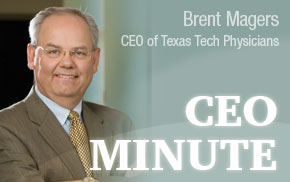 A patient of Texas Tech Physicians and a friend of mine who is a licensed health care
professional, told me not too long ago that she had made a request of one of our departments
and had been told what she wanted could not be done, there was no one in the clinic
that day that could help her, so forth and so on. Furthermore, she was told, “There
are several non-emergency clinics in town” and that she should try one of them. Ouch!
A patient of Texas Tech Physicians and a friend of mine who is a licensed health care
professional, told me not too long ago that she had made a request of one of our departments
and had been told what she wanted could not be done, there was no one in the clinic
that day that could help her, so forth and so on. Furthermore, she was told, “There
are several non-emergency clinics in town” and that she should try one of them. Ouch!Now, I must quickly add department leadership was very responsive and we got the situation straightened out. My friend received what she needed. We did service recovery and there was an acceptable outcome. But you always wonder in those situations: what impression did we leave? How many people did she tell?
Steven Little makes his living writing about leadership. He does what he calls the milkshake test — he asks room service for a milkshake. If he is told it is not on the menu, he walks employees through the list of ingredients. “Do you have vanilla ice cream?” Yes. “And milk?” Of course. “Do you have a tall glass and a long spoon?” Sure. If so, he tells them how to make one. If they are willing to do it, that’s a milkshake moment.
His point: When people understand the true purpose of their work, believe it is their job to fulfill it, and have the tools and freedom to make it happen — and then do it. That is the milkshake moment.
Now, some will say, “we are delivering health care, we are not serving milkshakes.” That may be, but what is Texas Tech Physicians’ highest purpose? Are we allowing people to be in the best position to accomplish it? Do we recognize those who step out and make a milkshake for the customer? Another might say, “You are advocating giving the patient what they want even if it is not in their best interest.” Absolutely not. Because, while we are striving for high patient satisfaction, we are also striving for quality and giving a person something not medically indicated is not high-quality medicine. So, it comes back to the balanced scorecard idea. Satisfaction, quality, financial performance, treating employees well, growing our business — all of these things are essential. And, together, form the key performance elements of our practice.
